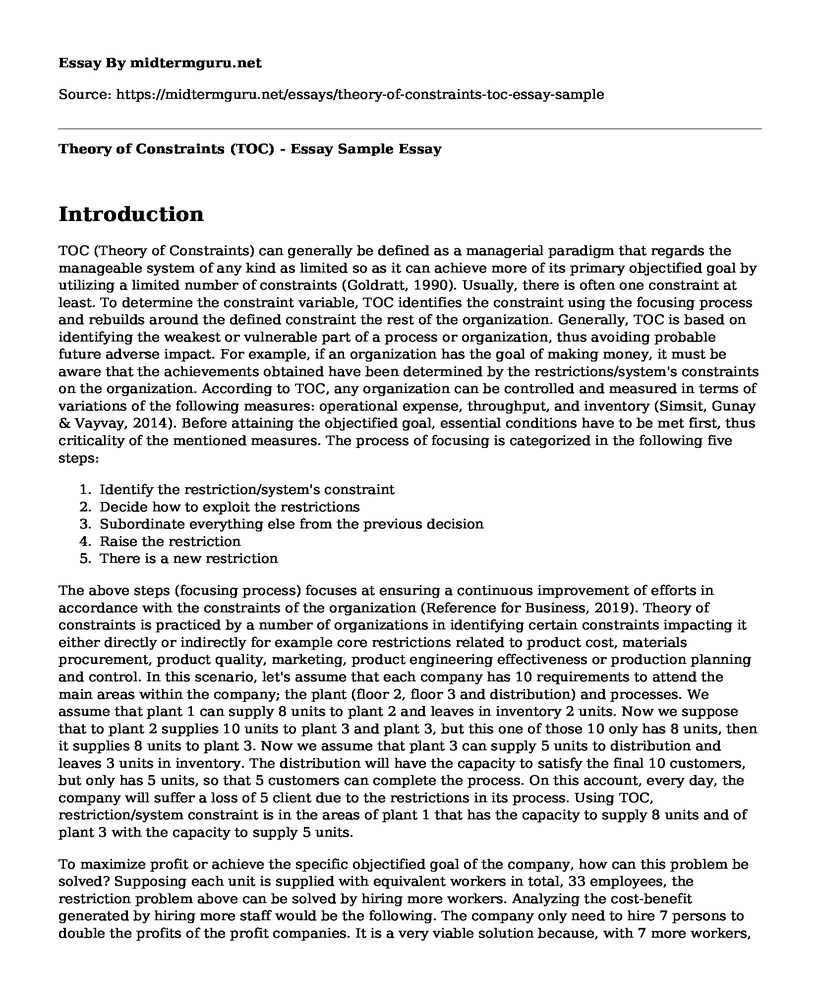Introduction
TOC (Theory of Constraints) can generally be defined as a managerial paradigm that regards the manageable system of any kind as limited so as it can achieve more of its primary objectified goal by utilizing a limited number of constraints (Goldratt, 1990). Usually, there is often one constraint at least. To determine the constraint variable, TOC identifies the constraint using the focusing process and rebuilds around the defined constraint the rest of the organization. Generally, TOC is based on identifying the weakest or vulnerable part of a process or organization, thus avoiding probable future adverse impact. For example, if an organization has the goal of making money, it must be aware that the achievements obtained have been determined by the restrictions/system's constraints on the organization. According to TOC, any organization can be controlled and measured in terms of variations of the following measures: operational expense, throughput, and inventory (Simsit, Gunay & Vayvay, 2014). Before attaining the objectified goal, essential conditions have to be met first, thus criticality of the mentioned measures. The process of focusing is categorized in the following five steps:
- Identify the restriction/system's constraint
- Decide how to exploit the restrictions
- Subordinate everything else from the previous decision
- Raise the restriction
- There is a new restriction
The above steps (focusing process) focuses at ensuring a continuous improvement of efforts in accordance with the constraints of the organization (Reference for Business, 2019). Theory of constraints is practiced by a number of organizations in identifying certain constraints impacting it either directly or indirectly for example core restrictions related to product cost, materials procurement, product quality, marketing, product engineering effectiveness or production planning and control. In this scenario, let's assume that each company has 10 requirements to attend the main areas within the company; the plant (floor 2, floor 3 and distribution) and processes. We assume that plant 1 can supply 8 units to plant 2 and leaves in inventory 2 units. Now we suppose that to plant 2 supplies 10 units to plant 3 and plant 3, but this one of those 10 only has 8 units, then it supplies 8 units to plant 3. Now we assume that plant 3 can supply 5 units to distribution and leaves 3 units in inventory. The distribution will have the capacity to satisfy the final 10 customers, but only has 5 units, so that 5 customers can complete the process. On this account, every day, the company will suffer a loss of 5 client due to the restrictions in its process. Using TOC, restriction/system constraint is in the areas of plant 1 that has the capacity to supply 8 units and of plant 3 with the capacity to supply 5 units.
To maximize profit or achieve the specific objectified goal of the company, how can this problem be solved? Supposing each unit is supplied with equivalent workers in total, 33 employees, the restriction problem above can be solved by hiring more workers. Analyzing the cost-benefit generated by hiring more staff would be the following. The company only need to hire 7 persons to double the profits of the profit companies. It is a very viable solution because, with 7 more workers, the needs of another client are supplied equivalent to twice the current earnings, thus boosting the company's revenue.
Conclusion
TOC management has various benefits to most companies worldwide though it is considered a long-term process. It is crucial that managers define the goal of the companies they are leading; these will help in decision making. To most is making a profit. The basic principles of the TOC are support elements to manage and carry out good process management. It is vital to identify the desired results and implement appropriate management approach throughout the increase.
References
Goldratt, E. M. (1990). Theory of constraints. Croton-on-Hudson: North River.
Reference for Business. (2019). Theory of Constraints. Retrieved from: https://www.referenceforbusiness.com/encyclopedia/Str-The/Theory-of-Constraints.html
Simsit, Z. T., Gunay, N. S., & Vayvay, O. (2014). Theory of constraints: a literature review. Procedia-Social and Behavioral Sciences, 150, 930-936. Retrieved from: https://www.sciencedirect.com/science/article/pii/S1877042814051532
Cite this page
Theory of Constraints (TOC) - Essay Sample. (2023, Jan 15). Retrieved from https://midtermguru.com/essays/theory-of-constraints-toc-essay-sample
If you are the original author of this essay and no longer wish to have it published on the midtermguru.com website, please click below to request its removal:
- Essay on Reinstating the Position of the Company in the Market: New Balance Company
- Essay Sample on Billabong International Limited
- Crazy Eddie - Case Study
- Empowering Managers to Create Teamwork and Goodwill in an Organization - Essay Sample
- Santander's Differentiation Strategy for Customer Value and Market Growth - Essay Sample
- The Power of Virtual Reality: Transforming Technology and Human Activities - Essay Sample
- Toyota's Environmental Pollution: Ethical Actions & Behaviour - Research Paper







